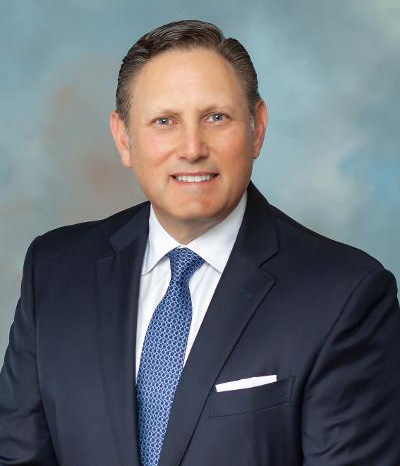“After three months, I went back to my workout classes. I’m so grateful to Dr. Levine. He’s our angel.”

Lourenza Mejia didn’t want spine surgery. “I put it off for more than three years,” says the Hamilton Township resident.
She wrestled with a dilemma that many people who are pondering surgery must address: At what point does pain, decreasing quality of life or the threat of poor health in the future make a significant procedure the best path forward?
Looking back, Lourenza is certain about her decision. “I love to tell my story,” she says. “If you have any spinal problem, don’t hesitate to see my surgeon and have him solve it.”
Pinching the Nerve
It was during an exercise class in 2017 that Lourenza noticed the first hint that something wasn’t right: a sensation she describes as a shock in her left leg. “It came from nowhere, would come and go, then stop,” she says. “I’d feel it for seconds, and that was it.”

The odd sensations at first didn’t affect her daily life. But she had worked as a biomedical lab technologist and had an inkling of what might be going on. Concerned, she consulted a doctor who had performed minimally invasive spine surgery on her husband, Juan Carlos Mejia, in 2009: Marc J. Levine, MD, Director of the Orthopedic Spine Surgery Program in the Orthopedic & Spine Institute at Robert Wood Johnson University Hospital (RWJUH) Hamilton and a member of RWJBarnabas Health Medical Group.
“Dr. Levine ordered an MRI,” Lourenza recalls. The results weren’t encouraging. “He told me I had spondylolisthesis,” she says.
Spondylolisthesis is a condition in which one bony vertebra of the spine slips forward in relation to the vertebra below it. In Lourenza’s case, this occurred between the L4 and L5 vertebrae, which meant she had a structural defect in the lumbar spine of her lower back, an area that’s subject to stress during normal movement.
“The vertebrae are essentially blocks of bone connected to a ring that encloses the spinal cord running down the middle,” Dr. Levine says. “When one ring moves forward, there’s less space in the middle where the nerves are.” That can pinch nerves in the spinal canal, causing a range of symptoms, including pain.
Lourenza likely had been predisposed to the condition at birth. “She’s a very active person, and the problem developed due to excess stress over many years,” Dr. Levine says. Surgery can resolve the issue, but Lourenza was hesitant. Then her symptoms became markedly worse.
A Timely Decision
“In 2019, I started feeling tingling and numbness in my feet,” Lourenza says. “I knew my main spinal nerve was being compressed.” She especially felt numb when standing or walking. When on her feet, she began holding on to her husband for support. “The numbness feeling was terrible,” she says. “I started feeling unsafe due to the sense that I could fall at any moment.”
The value of surgery started to become clear. “At this point, I was more scared to become dependent on others than to go for surgery,” Lourenza says. “Surgery offered a chance to have my life back.”
Further delay could have restricted future treatment. “In this type of pathology, if people wait too long, a deformity can progress to a point where it limits the minimally invasive approaches that we were able to use in her case,” Dr. Levine says.
He recommends seeing a doctor early in a degenerative process and monitoring progress over time. “If there are no symptoms, there usually is no surgery,” he says. “But if there are symptoms and a deformity is worsening, you may have fewer options if the deformity gets past a certain point from a structural standpoint.”
Lourenza decided to proceed with surgery in September 2021 at RWJUH Hamilton both because the hospital was right in her own community and because her husband’s earlier spine surgery had turned out well. “I trusted Dr. Levine,” she says.
Sparing the Back
“We used a relatively new minimally invasive procedure called an extreme lateral interbody fusion,” Dr. Levine says. The procedure accesses the spine through small incisions in the side rather than through the back or front of the body. “This approach doesn’t disrupt major back muscles and avoids the often painful long-term problems people can have with open procedures,” he says.
Dr. Levine placed a titanium implant in Lourenza’s spine and locked it in place with a plate and screws. Special imaging called fluoroscopic intraoperative imaging took continuous X-rays that provided the surgical team video-like views of the spine as they worked.
“The implant allows us to realign, fix and fuse the spine, which takes pressure off the nerve and prevents the deformity from worsening,” Dr. Levine says. “These minimally invasive procedures allow patients to recover much more quickly with less pain than they would with traditional open surgeries. Many times, results can be dramatic and truly surprise people.”
Lourenza was among the amazed. “Starting about three hours after surgery, I was able to stand without any symptoms,” she says. “No pain, no numbness, no tingling—nothing!” Just as remarkable, she required no physical therapy after surgery. “The only exercise indicated by Dr. Levine was to walk, walk, walk as much as possible,” Lourenza says. “After three months, I went back to my workout classes. I’m so grateful to Dr. Levine. He’s our angel.”
To learn more about the Orthopedic Spine Surgery Program at the Orthopedic & Spine Institute at Robert Wood Johnson University Hospital Hamilton, call 609-689-7031.
Generous donations to RWJUH Hamilton benefit patients like Lourenza who rely on us for their health care needs, no matter how complex.
Please consider making an online tax-deductible donation today.